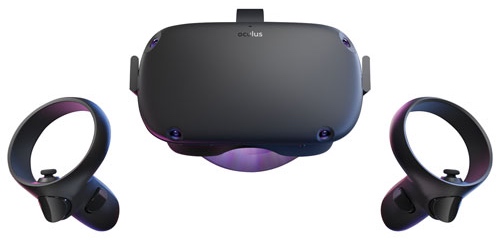
Finally we have found some VR hardware that we think is suited to architectural offices – the Oculus Quest.
You might rightfully wonder why we have been waiting for so long to jump onto the VR train?
It is simple really, we have seen a many expensive VR systems come and go and were not impressed beyond the initial WOW factor.
We think the below requirements are essential to make VR headsets work in most architectural offices:
- convenience > do you need to be tethered via cables to some other box in a dedicated area (for tracking sensor setup) and do you require skilled operators every time you want to use the VR setup?
- compatibility > do you need to invest in additional hard or software?
- practicality > how do you get a model on your VR headset from macOS BIM / CAD software packages, i.e. ARCHICAD, Vectorworks, SketchUP or Rhino?
- interaction > can you see what the VR headset user sees, or even better can I join them and show them around?
So let’s see how the Quest fares against the above criteria.
convenience > 5/5
The Quest is completely self contained, and setup could not be easier via the iOS setup. For VR novices it includes a Tutorial that is a perfect introduction to the navigation via the two handheld controllers.
compatibility > 0/5 on macOS (3/5 on windows)
Unfortunately, the model conversion & upload process to the Oculus Quest is still not mac compatible – we have tested a few apps and currently PROSPECT by IRIS VR is our clear favourite (although this might change as more Software will support the QUEST).
practicality > 1/5
Unfortunately there is currently no easy way to export an ARCHICAD model directly into the QUEST directly from macOS – let’s hope this will change soon, we will update this post once someone comes up with a good solution.
However, what you can already do, is to export your ARCHICAD model to SKETCHUP and upload this to the QUEST via PROSPECT running on Windows.
interaction > 4/5
With PROSPECT you can cast the QUEST screen either to an iOS device or via an iOS device directly to a Google Chromecast (currently 3rd gen and Ultra are supported). Note you can also share your iOS screen to an Apple TV, but this is not built into PROSPECT itself.
PROSPECT also allows for online collaboration, i.e. multiple users can join and view the same project at the same time. So far we have not had the opportunity to test this feature, but will report back once this we have.
final thoughts
Overall the Oculus QUEST itself works really well and both the headset and controllers have good built quality. Some users have reported problems with the controller battery cover coming off, but we have not had any problems.
Given the self contained nature of the QUEST, rendering capabilities are obviously limited. In other words PROSPECT’s model display is not anywhere near photo realistic and although you can control the sun position based on time and date for ambient lighting, it does currently not display any cast shadows.
Despite the graphical limitations, everyone we have tested the QUEST with agreed, that it improves the understanding of scale and provides the ability to verify spatial quality.
Initially we had some issues with some high polygon count SKUP models, however once we controlled our entourage & landscape elements then we had no further problems importing models (up to 200MB) via PROSPECT.
Please note we are also impressed by IRIS VRs frequent updates to PROSPECT, which have continuously improved the software.
In addition Facebook has recently announced that they will allow tethering of the QUEST to external hardware to tap into additional graphics performance. We will have to see if this will make any difference to how PROSPECT renders shadows.
For a detailed look at our current setup and a comparison of the officially recommended hardware by IRIS VR, please refer to our other blog entry here.
Please note Oculus is owned by Facebook, so we recommend to dial up any facebook related privacy settings – if they really do anything…